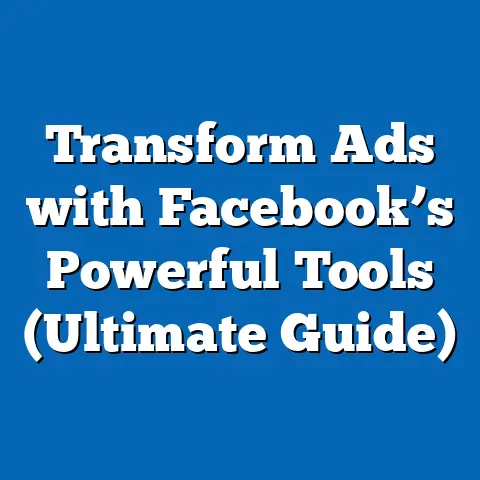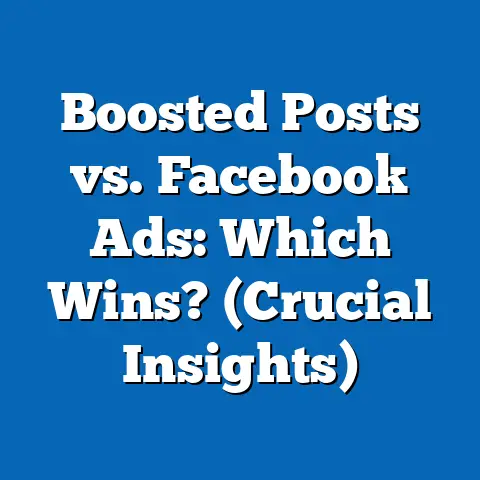Can You Use Different fb ad Sets for the Same Ad? (Expert Guide)
Many marketers operate under the assumption that once a Facebook ad is created, it’s confined to a single ad set. This belief is not only a misconception but also a significant limitation on your advertising potential. I’ve seen firsthand how breaking free from this constraint can unlock new levels of campaign performance.
Understanding ad sets and their pivotal role in Facebook advertising is crucial. They’re the engine that drives your ads to the right audience, within the right budget, and at the right time. In this guide, I’ll dive deep into the nuances of using different ad sets for the same ad, debunking myths, sharing best practices, and providing real-world examples to help you maximize your Facebook advertising ROI.
Understanding Facebook Ad Structure
Before we dive into the nitty-gritty, let’s establish a clear understanding of the Facebook advertising hierarchy. Think of it as a pyramid, with each level building upon the last:
- Campaign: This is the overarching goal of your advertising efforts. Are you aiming for brand awareness, lead generation, or website conversions? Your campaign objective sets the stage for everything else.
- Ad Set: This level defines who will see your ad, where your ad will be shown (placement), when it will be shown (schedule), and how much you’re willing to spend (budget). The ad set is where you define your target audience using demographics, interests, behaviors, and more.
- Ad: This is the creative itself – the image, video, text, and call-to-action that your audience will see. The ad is the messenger that delivers your message to your target audience.
The Function of Ad Sets
The ad set is the powerhouse of your Facebook ad campaign. It’s where you define the parameters that dictate who sees your ad and how your budget is allocated. Here’s a breakdown of its key functions:
- Audience Targeting: This is arguably the most critical function. You can target users based on demographics (age, gender, location), interests (hobbies, passions, brands they follow), behaviors (past purchases, online activity), and connections (friends of people who like your page). You can also create custom audiences based on your existing customer data or website visitors, and lookalike audiences based on your best customers.
- Budget Allocation: You set a daily or lifetime budget for each ad set. This determines how much Facebook will spend to show your ad to your target audience.
- Bidding Strategy: You can choose from various bidding strategies, such as lowest cost, cost cap, or target cost, to control how Facebook bids on ad placements.
- Placement: You select where your ads will appear, such as Facebook news feed, Instagram feed, Audience Network, Messenger, etc. You can choose automatic placements (letting Facebook decide) or manual placements (selecting specific placements).
- Scheduling: You can set a start and end date for your ad set, or run it continuously. You can also specify the times of day when your ads will be shown.
The Significance of Ad Creative
Your ad creative is the visual and textual representation of your message. It’s what grabs your audience’s attention and encourages them to take action. Compelling ad creative is essential for driving results, regardless of how well your ad set is targeted. Think of it as the hook that reels in your audience.
Your ad creative should be:
- Relevant: It should resonate with your target audience and align with their interests and needs.
- Engaging: It should capture their attention and encourage them to interact with your ad.
- Clear: It should clearly communicate your message and call-to-action.
- Visually Appealing: It should be high-quality and visually attractive.
Takeaway: Understanding the Facebook ad structure is essential for creating effective campaigns. The ad set is the control panel that determines who sees your ad and how your budget is spent, while the ad creative is the message that resonates with your audience.
The Myth Explained
Now, let’s address the elephant in the room: the myth that one ad can only live in one ad set. This is a widespread belief, and I’ve heard it echoed in countless marketing forums and conversations. The idea is that once you create an ad, it’s somehow “tied” to the ad set it was initially created within.
Why This Belief Exists
So, where does this myth come from? There are a few contributing factors:
- Misinterpretation of Facebook’s Interface: The Facebook Ads Manager interface can be overwhelming, especially for beginners. The way ads are created and managed within ad sets can lead to the assumption that they are inextricably linked.
- Default Settings and Assumptions: When you create an ad, it’s naturally associated with the ad set you’re currently working in. Many marketers simply accept this default setting without exploring other options.
- Fear of Duplication: Some marketers worry that duplicating ads across multiple ad sets will somehow confuse Facebook’s algorithm or negatively impact performance.
- Lack of Experimentation: The simplest explanation is that many marketers have simply never tried using the same ad in different ad sets. They stick to what they know and are hesitant to experiment with new strategies.
Examples of the Myth in Action
Here are some scenarios where advertisers might mistakenly believe this myth:
- Scenario 1: A/B Testing: A marketer wants to A/B test different ad creatives. They create two ad sets, each with a different version of the ad. They mistakenly believe they can’t use the same ad creative in both ad sets, so they unnecessarily duplicate the ad creative, leading to confusion and potential performance issues.
- Scenario 2: Audience Segmentation: A business wants to target different customer segments with the same core message. They believe they need to create separate ads for each segment, even though the underlying message is the same.
- Scenario 3: Placement Optimization: An advertiser wants to test different ad placements (e.g., Facebook feed vs. Instagram feed). They mistakenly believe they need to create separate ads for each placement, even though the ad creative is identical.
Takeaway: The myth that one ad can only live in one ad set is a common misconception that stems from misinterpretations of Facebook’s interface, default settings, and a lack of experimentation.
The Reality of Using One Ad Across Multiple Ad Sets
Let’s set the record straight: it is absolutely possible, and often beneficial, to use the same ad across multiple ad sets. In fact, this is a powerful strategy that can significantly improve your campaign performance.
Benefits of Using One Ad Across Multiple Ad Sets
Here’s why you should consider using the same ad in different ad sets:
- Improved Reach and Efficiency: By using the same ad in multiple ad sets, you can reach a wider audience without creating duplicate ads. This can save you time and effort, and improve your overall efficiency.
- Audience Testing and Optimization: You can test different audience segments with the same ad to see which ones respond best. This allows you to refine your targeting and optimize your campaigns for maximum ROI. For example, you can test the same ad with a broad audience versus a highly targeted audience to see which performs better.
- Placement Optimization: You can test different ad placements with the same ad to see which ones drive the best results. This allows you to identify the most effective placements for your ad creative.
- Budget Optimization: By monitoring the performance of the same ad across different ad sets, you can identify which ad sets are delivering the best results and allocate your budget accordingly.
- Consistency and Brand Messaging: Using the same ad across multiple ad sets ensures consistency in your brand messaging and visual identity. This can help strengthen brand recognition and build trust with your audience.
Implications for Tracking and Analytics
When using one ad in multiple ad sets, it’s crucial to understand how tracking and analytics work. Facebook Ads Manager will aggregate the performance data for each ad across all ad sets. This means you can see the overall performance of the ad, as well as the performance within each individual ad set.
Here’s what you need to keep in mind:
- Ad-Level Metrics: You can view metrics like impressions, clicks, conversions, and cost-per-result at the ad level. This gives you an overall picture of how the ad is performing across all ad sets.
- Ad Set-Level Metrics: You can also view metrics at the ad set level. This allows you to see how the ad is performing within each specific ad set, taking into account the targeting, budget, and placement settings of that ad set.
- Attribution: Facebook uses attribution models to determine which ad set gets credit for a conversion. Understanding these models is crucial for accurately interpreting your data.
- Custom Reporting: You can create custom reports in Facebook Ads Manager to track specific metrics and analyze performance across different ad sets.
Takeaway: Using the same ad across multiple ad sets is a powerful strategy for improving reach, testing audiences and placements, optimizing budgets, and maintaining brand consistency. Understanding how tracking and analytics work is crucial for accurately interpreting your data.
Best Practices for Implementing This Strategy
Now that you understand the benefits of using one ad across multiple ad sets, let’s dive into the practical steps for implementing this strategy effectively.
Step-by-Step Guide to Duplicating Ads
Here’s a step-by-step guide on how to duplicate an ad across different ad sets:
- Navigate to Ads Manager: Open Facebook Ads Manager and select the campaign and ad set that contains the ad you want to duplicate.
- Select the Ad: Find the ad you want to duplicate and check the box next to it.
- Duplicate the Ad: Click the “Duplicate” button. You’ll be presented with options for duplicating the ad within the same ad set or in a new ad set.
- Choose “Existing Campaign”: Select the “Existing Campaign” option. This will allow you to choose a different ad set within the same campaign.
- Select the Target Ad Set: Choose the ad set where you want to use the same ad.
- Review and Publish: Review the duplicated ad and make any necessary adjustments. Then, click “Publish” to activate the ad in the new ad set.
Managing and Monitoring Performance
Once you’ve duplicated your ad across multiple ad sets, it’s crucial to manage and monitor its performance effectively. Here are some tips:
- Regularly Check Performance: Monitor the performance of the ad in each ad set. Pay attention to metrics like impressions, clicks, conversions, and cost-per-result.
- Identify Top Performers: Identify which ad sets are delivering the best results. These are the ad sets where your ad is resonating most strongly with your target audience.
- Optimize Low Performers: If you notice that an ad set is underperforming, try adjusting the targeting, budget, or placement settings. You can also try creating a new ad creative specifically for that ad set.
- Allocate Budget Accordingly: Allocate more of your budget to the ad sets that are delivering the best results. This will help you maximize your ROI.
- Use Custom Reporting: Create custom reports in Facebook Ads Manager to track specific metrics and analyze performance across different ad sets. This will give you a more granular understanding of how your ads are performing.
Analyzing Data for Optimal Performance
Analyzing data is key to understanding which ad set is performing best. Here are some tips:
- Compare Ad Set Performance: Compare the performance of the ad across different ad sets. Look for patterns and trends that can help you understand what’s working and what’s not.
- Segment Your Data: Segment your data by demographics, interests, behaviors, and placements. This will help you identify the specific factors that are driving performance.
- Use Attribution Modeling: Understand how Facebook’s attribution models work and use them to accurately attribute conversions to the correct ad sets.
- Test and Iterate: Continuously test different targeting, budget, and placement settings to optimize your campaigns for maximum ROI.
Takeaway: Duplicating ads across different ad sets is a simple process that can significantly improve your campaign performance. Managing and monitoring performance, and analyzing data effectively, are crucial for maximizing your ROI.
Case Studies and Real-World Examples
To further illustrate the effectiveness of using the same ad in different ad sets, let’s look at some real-world examples.
Case Study 1: E-commerce Brand Targeting Different Customer Segments
An e-commerce brand selling organic skincare products wanted to reach different customer segments with the same core message about the benefits of natural ingredients.
- Strategy: They created one ad with compelling visuals showcasing their products and highlighting the natural ingredients. They then duplicated this ad across three different ad sets:
- Ad Set 1: Targeted women aged 25-45 interested in organic skincare.
- Ad Set 2: Targeted environmentally conscious consumers interested in sustainable products.
- Ad Set 3: Targeted users who had previously visited their website and viewed specific product pages.
- Results: They found that Ad Set 1 and Ad Set 3 performed significantly better than Ad Set 2. They then reallocated their budget to focus on the top-performing ad sets, resulting in a 30% increase in sales.
- Lesson Learned: Testing different audience segments with the same ad can help you identify your most valuable customers and optimize your targeting for maximum ROI.
- Ad Set 1: Targeted women aged 25-45 interested in organic skincare.
- Ad Set 2: Targeted environmentally conscious consumers interested in sustainable products.
- Ad Set 3: Targeted users who had previously visited their website and viewed specific product pages.
Case Study 2: Local Restaurant Testing Different Ad Placements
A local restaurant wanted to promote a new lunch special and attract more customers during the week.
- Strategy: They created one ad with mouthwatering photos of their lunch special and a clear call-to-action to “Order Now.” They then duplicated this ad across three different ad sets, each targeting a different ad placement:
- Ad Set 1: Facebook News Feed
- Ad Set 2: Instagram Feed
- Ad Set 3: Facebook Marketplace
- Results: They found that Ad Set 1 (Facebook News Feed) delivered the best results, with the highest click-through rate and lowest cost-per-click. They then focused their budget on the Facebook News Feed placement, resulting in a 20% increase in lunch orders.
- Lesson Learned: Testing different ad placements with the same ad can help you identify the most effective placements for your ad creative and optimize your campaigns for maximum ROI.
- Ad Set 1: Facebook News Feed
- Ad Set 2: Instagram Feed
- Ad Set 3: Facebook Marketplace
Case Study 3: SaaS Company Retargeting Website Visitors
A SaaS company wanted to retarget website visitors who had shown interest in their product but hadn’t signed up for a free trial.
- Strategy: They created one ad with a compelling headline, a brief description of their product, and a clear call-to-action to “Start Your Free Trial.” They then duplicated this ad across two different ad sets:
- Ad Set 1: Retargeted website visitors who had visited the pricing page.
- Ad Set 2: Retargeted website visitors who had viewed a specific product demo video.
- Results: They found that Ad Set 2 (retargeting viewers of the product demo video) performed significantly better than Ad Set 1 (retargeting visitors to the pricing page). They then focused their budget on the ad set targeting video viewers, resulting in a 40% increase in free trial sign-ups.
- Lesson Learned: Retargeting specific website visitors based on their behavior can be a highly effective strategy for driving conversions.
- Ad Set 1: Retargeted website visitors who had visited the pricing page.
- Ad Set 2: Retargeted website visitors who had viewed a specific product demo video.
Takeaway: These case studies demonstrate the power of using the same ad in different ad sets to test audiences, placements, and retargeting strategies. By carefully analyzing the results, you can optimize your campaigns for maximum ROI.
Potential Challenges and Misconceptions
While using the same ad across multiple ad sets can be a powerful strategy, it’s important to be aware of potential challenges and misconceptions.
Ad Fatigue
One of the biggest challenges is ad fatigue. If the same ad is shown to the same audience too many times, they may become desensitized to it, leading to a decrease in performance.
Here’s how to mitigate ad fatigue:
- Rotate Your Ads: Regularly rotate your ad creatives to keep your audience engaged.
- Refresh Your Targeting: Periodically refresh your targeting to reach new users.
- Use Frequency Caps: Set frequency caps in Facebook Ads Manager to limit the number of times an individual user sees your ad.
Audience Overlap
Another potential challenge is audience overlap. If your ad sets target similar audiences, you may be competing against yourself, driving up costs and cannibalizing your results.
Here’s how to avoid audience overlap:
- Define Your Audiences Clearly: Clearly define your target audiences for each ad set.
- Use Audience Exclusion: Use audience exclusion to prevent your ad sets from targeting the same users.
- Monitor Your Performance: Regularly monitor the performance of your ad sets and adjust your targeting as needed.
Misinterpreting Performance Data
When using the same ad across multiple ad sets, it’s important to avoid misinterpreting performance data. You need to understand how Facebook Ads Manager aggregates data and how attribution models work.
Here are some tips for accurately interpreting your data:
- Focus on Ad Set-Level Metrics: Pay close attention to the ad set-level metrics, as these will give you the most accurate picture of how the ad is performing within each specific ad set.
- Understand Attribution Models: Understand how Facebook’s attribution models work and use them to accurately attribute conversions to the correct ad sets.
- Use Custom Reporting: Create custom reports in Facebook Ads Manager to track specific metrics and analyze performance across different ad sets.
Common Misconceptions
Here are some common misconceptions about using the same ad across multiple ad sets:
- “It Confuses the Algorithm”: This is simply not true. Facebook’s algorithm is designed to optimize for the best results, regardless of how many ad sets an ad is used in.
- “It Leads to Higher Costs”: This is not necessarily true. In fact, using the same ad across multiple ad sets can often lead to lower costs, as you’re able to reach a wider audience more efficiently.
- “It’s Too Complicated”: This is also not true. Duplicating ads across different ad sets is a simple process that can be done in just a few clicks.
Takeaway: While there are potential challenges and misconceptions associated with using the same ad across multiple ad sets, these can be easily mitigated with careful planning, monitoring, and analysis.
Conclusion
In this guide, I’ve debunked the myth that one Facebook ad can only live in one ad set. I’ve shown you that it’s not only possible, but often beneficial, to use the same ad across multiple ad sets. This strategy can improve your reach, test different audiences, optimize your budget, and maintain brand consistency.
By following the best practices outlined in this guide, you can effectively implement this strategy and maximize your Facebook advertising ROI. Remember to regularly monitor your performance, analyze your data, and adapt your approach as needed.
I encourage you to rethink your approach to Facebook ads and consider implementing this strategy in your next campaign. Break free from the limitations of the “one ad, one ad set” mentality and unlock the full potential of your Facebook advertising efforts. The results, as I’ve personally witnessed, can be transformative.






